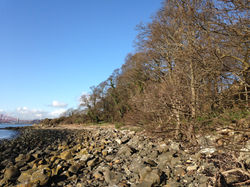Emerging Bumblebees
Now that we have had a few days of sunshine and little wind, many of you will be seeing Bumblebees in the garden, sometimes visiting the flowers that provide nectar for pollinators. You will also see some flying low over the ground in a random zigzag pattern; they are looking for places for building nests. Some people may find these large buzzing insects a bit intimidating, but they won't sting unles you grab hold of them. They have far more important things to do.
At the moment, almost all will be the queen bumblebees that have been emerging from their long winter hibernation, and they need some nectar producing flowers to power their searches. The first photos are of two of the most frequently seen around here early in the year. Here taking advantage of a Flowering Currant, a popular bush with Bumblebees just now.
The big black one with dull yellow stripes is the Buff-tailed Bumblebee. This is the common one most often seen in early spring. There have been some around in the garden since late February mostly on winter flowering heathers.

The other one shown here, with the white tail and smart orange thorax, is the Tree Bumblebee. They have been around in the garden since mid March. The species arrived from France in 2001 and having become established in the south has been steadily spreading north since then. The first one was sighted in Dalgety Bay in 2015.

Once these queens have found a suitable place to nest they will become much less obvious. When they have built up a stock of nectar and pollen they will lay eggs and care for the first brood of workers in the nest. The workers will emerge a few weeks later and then the summer abundance of bumblebees will begin.
There are two others that I have seen more recently, they are the Early Bumblebee shown here in a photo from 2014. They are similar to the Buff-tailed but much smaller and have a pinky/buff tail and they can often be seen visiting Red Dead-nettle which is also in flower now.

The other one, seen only a couple of days ago is the Red-tailed shown in a 2015 photo. Very distinct with the jet black body and red tail.

There are two others that are still to show themselves, at least in my garden, they are the Garden and the Common Carder. Both are shown below in older photos.

The Common Carder (below) is the only one to be completely orange all over.








































